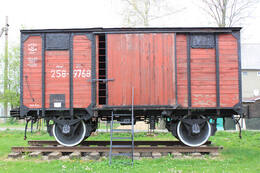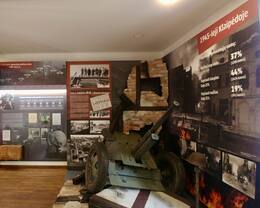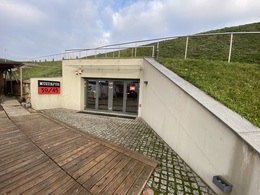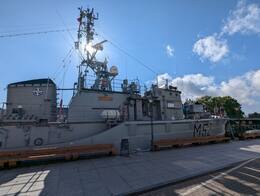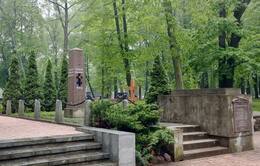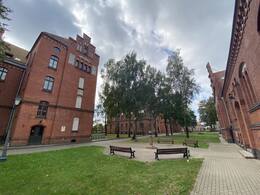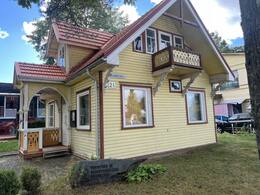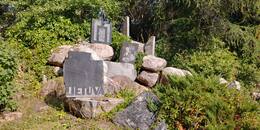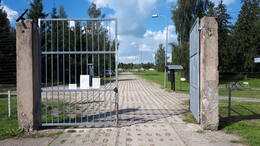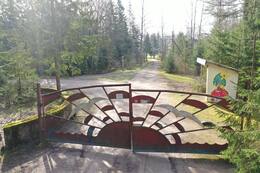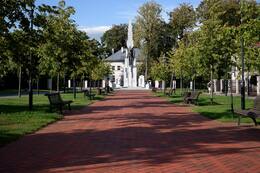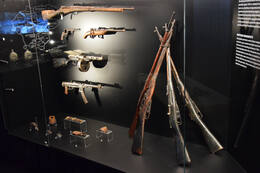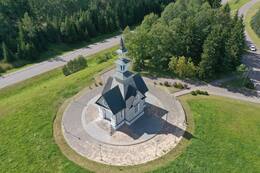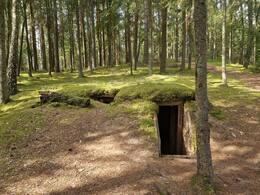Legacy of the Cold War and Soviet Occupation in Žemaitija
Museum of the History of Freedom Fights and Exile in Priekulė
In Priekulė, on Klaipėdos Street (there is a directional sign).
The museum is located in the buildings of the former East Prussian gendarmerie station. They were built in 1909 according to a typical project. After the war, the buildings were occupied by Soviet repressive structures: in 1945–1950, the NKVD-MVD-MGB Priekulė parish subdivision operated here, in 1950–1953, the MGB Priekulė district department, and in 1946–1953, the Priekulė riot police headquarters were also located here. People were interrogated and tortured in the main building of the former station and its basement, detainees were imprisoned in the former farm building, and the bodies of the murdered were dumped in another building. The bodies were later buried in the garden deep in the plot or taken out and dumped in a peat bog in Drukiai.
The museum opened its doors in these premises in 2006. The main themes of the exposition are the post-war resistance struggle and deportations in this Klaipėda region. The museum also has an outdoor exposition: a deportation wagon and a replica of a partisan bunker are on display. Signs of memory have been created on the museum territory: a chapel has been installed, chapel pillars created by folk artists stand, and a memorial has been built on the site of a mass grave.
Exposition “Sovietmečio pėdsakais” (“In the Footsteps of the Soviet Era”) at the History Museum of Lithuania Minor
The exposition is located in the central part of Klaipėda. When the Soviets occupied Lithuania in 1940, Klaipėda and the region of Klaipėda were already part of the German Reich. In January 1945, Klaipėda was captured by the Red Army. According to the registration data of the war commandant, only 28 civilians were left in the town at the time. The new Soviet period in Klaipėda began. One repressive regime was replaced with another.
The exposition “Sovietmečio pėdsakais” (“In the Footsteps of the Soviet Era”) aims to reflect the Soviet era and the changes that began in the late 1990s and to help understand the complex Soviet atmosphere. The exposition tells the story of the new inhabitants, the construction of the “socialist” Klaipėda, the Soviet ideology and propaganda efforts, the desire to destroy everything that was national, folk and civic, as well as religious consciousness. Different stories and themes are revealed: the interior of a Soviet-era living room of an intelligent person illustrates the everyday life of people of that time; an improvised “red corner” and the Soviet slogans reflect the methods and banality of Soviet propaganda; a computer terminal demonstrates the construction of Blessed Virgin Mary, Queen of Peace Church in Klaipėda and its fate in 1957–1963, etc.
World War II Exposition “Muziejus 39/45”
“Muziejus 39/45”, which belongs to the History Museum of Lithuania Minor, tells the story of the Second World War events in Klaipėda and the region. The museum is located under a rampart on the eastern side of the former Klaipėda Castle, where German troops had set up an explosives depot during the war.
The exposition of the museum is modern and engaging for visitors: the exposition consists of four halls that present different periods of the wartime, and 13 interactive points have been installed in the halls. The hall “Klaipėda on the Eve of War” displays historical documents and photos, while the radical changes in Europe of the time are described on an original animated map. The hall “The Storming of Klaipėda” reflects the very tragic history of Klaipėda and its inhabitants, while the second hall “Klaipėda after the War” features an installation commemorating the demolished churches of the city. The last one – the Hall of Memories – features a symbolic six-metre-long carriage with a glass roof, under which multiple simple household objects that once belonged to both German soldiers and Klaipėda civilians are on display. The glass is coated with a layer of sand, so you have to brush the sand off with your fingers to see the exhibits.
Mine countermeasures ship-museum M52 "Sūduvis"
The M52 “Sūduvis” mine countermeasures ship-museum is located on the Karališkoji Danės waterfront of Klaipėda, next to Castle Bridge.
It is a “Lindau” mine trawler class ship, built in 1956–1958 in West Germany. The mission of these ships is to detect and destroy sea mines. The hull was therefore made of Brazilian oak, the deck of teak, and the machinery, of non-magnetic metal.
From 1958 to 1999, the ship belonged to the German Navy and was named M1071 “Koblenz”. From 1978–1979, it was converted from a mine trawler to a mine hunter.
In 1999, the ship was transferred to the Lithuanian Navy. Navy ships are traditionally named after historical regions of Lithuania, so the received ship was also named M52 “Sūduvis”. The ship served Lithuania for 22 years, taking part in international and national exercises and operations. In 2021, the ship left the service of the Lithuanian Navy and was handed over to the Lithuanian Maritime Museum. Then, 52 “Sūduvis” was opened to the public and adapted for the needs of museum and educational use. The vessel on display has authentic operational equipment.
Sculpture Park in Klaipėda
The park is located in Klaipėda between K. Donelaičio, Liepų, Trilapio and S. Daukanto streets.
Sculpture Park in Klaipėda is a multi-layered witness to the history of the city and of the world. A cemetery, a park, a memorial, a place for art – all this and more can be accommodated in one area.
In 1944–1945, the Soviet occupiers regained their positions in ithuania, but Klaipėda was left without its old inhabitants. The once new, now old, city cemetery was left neglected. Finally, in 1977, it was disposed of, a Sculpture Park was built instead, and the installation of artworks began.
Today, the park is known as an open-air sculpture gallery of Lithuania’s mature modernism. 116 works created during the Soviet period (1977–1989) are on display here. Alongside works of art and relics of the ancient cemetery, monuments are also displayed here:
• Memorial to the events of the 1923 Klaipėda Uprising (1925);
• Memorial to the Soviet soldiers of World War II (1949–1980), part
of which was dismantled in 2022 after the outbreak of the war
of Russia against Ukraine;
• a memorial stone to the old inhabitants of Klaipėda – the
Memelenders (1992).
French prisoners of the Franco-Prussian War, German Imperial soldiers of the First World War, soldiers of Independent Lithuania, Belgian, Polish and French prisoners of the Second World War are also honoured with commemorative signs.
Complex of Barracks in Klaipėda (now Klaipėda University buildings)
Although the complex of barracks in Klaipėda was a military facility, today the barracks have been converted by the University of Klaipėda for its own use, and the former military campus preserves multiple remnants of its military past.
The barracks were built in 1904–1907 under a contract between the Magistrate of Klaipėda and the Prussian Military Administration. The finished barracks complex (architect unknown) consisted of eight main (brick) buildings, six of which have survived to date, and a wooden auxiliary building. The two main buildings were intended for the accommodation of soldiers. Sub-lieutenants and lieutenants used to live in the buildings along what is now Herkaus Manto Street.
From 1907 to 1914, the barracks housed the 3rd Battalion of the 41st “von Boyen” infantry Regiment, which fought on the Eastern Front during World War I and, in 1916, at the famous Battle of Verdun. From 1919–1920, the barracks were used by the volunteer battalion of the 41st Infantry Regiment of the Prussian Volunteer Corps, which was being formed at the time, as well as one battalion of the 223rd Regiment and one battalion of the 103rd Regiment that were sent to Klaipėda. From 1920–1923, the barracks belonged to the 21st Infantry Riflemen Battalion of the French Army, from 1923–1934 – to the 7th Infantry Regiment of the Duke of Žemaitija Butigeidis of the Lithuanian Army, and from 1934–1939 – to the 6th Regiment of the Duke of Pilėnai Margiris. The former military town can only be seen from the outside.
Museum of Exile and Resistance in Palanga
The museum is located in downtown Palanga, in one of the smallest wooden villas of the Palanga resort – Vaidilutė. It was established in 1993, based on the initiative of the Palanga branch of the Lithuanian Union of Political Prisoners and Deportees. The department continues to look after the museum today on a community basis. The volunteers have adapted the villa to the specific needs of the museum and lead the tours themselves.
The exhibition tells the story of the participation of Lithuanians in the resistance movement and the deportations that destroyed people’s lives.
Orvidai Homestead-Museum
The Orvidai Homestead-Museum is located near Salantai, on the right side of the road Salantai-Plungė (KK169) (there are information signs).
The site was started more than 40 years ago by a family ofstone cutters – a father and son – Kazimieras and Vilius Orvidai (1905–1989; 1952–1992). During the land improvement works, they brought interesting-looking stones scheduled for crushing and centuries-old trees from the surrounding fields to their homestead and used them to create religious monuments. The works created by the Orvidai themselves at their farm homestead, as well as works by other artists displayed there did not conform to Soviet ideological and artistic canons: the works made of stone, wood, metal and old agricultural tools intertwined the symbolism of different religions (Catholic, Pagan, Buddhist). The homestead was also well known to those who did not fit into the reality of Soviet life. The place became a site of refuge and gathering for those who thought differently. The Soviet power repeatedly planned to destroy this environment, however, people managed to preserve it. The Orvidai homestead became very popular during the Lithuanian revival.
An IS-2 tank welcomes visitors at the Orvidai Homestead-Museum. This tank was developed by the Soviet Union during World War II as a response to the German Tiger I. The name IS is an acronym for the Soviet tyrant Joseph Stalin. This tank was formerly located in Salantai as part of the Memorial dedicated to the World War II Soviet burial. In 1991, it was relocated to the Orvidai homestead and became an exhibit.
Cold War exposition
On 31 December 1962, one of the first underground launch complexes for R-12 ballistic missiles in the Soviet Union, the Dvina underground launch complex, was put into operation
in Plokštinė Forest (Plungė district).
Between 1963 and 1978, four R12 medium-range ballistic missiles (SS-4 Sandal) equipped with a 2.3-megatonne nuclear warhead were deployed at the complex. All the missiles were aimed at Western European countries. This complex, together with similar surface-launched missile bases, formed a single Soviet nuclear arsenal in Lithuania, which was capable of destroying the whole of Europe. In its 16 years of operation, not a single missile was fired, despite the declaration of combat readiness during the Prague Spring in 1968.
After the Soviet soldiers left on 18 June 1978, the poorly guarded military facility was vandalised and looted. In 1993, when the complex was handed over to the Žemaitija National Park Directorate, its restoration began. In 2012, the Cold War exposition was opened. Today, this once very secret and guarded place is open to the public. A historical exposition on the Cold War period is on display at the former missile and equipment control room house. To date, it is the only museum in urope where a preserved underground missile launch silo is on display.
Plokštinė Military Town
In 1962, one of the first underground launch complexes for R-12 ballistic missiles in the Soviet Union, the Dvina, was put into operation in Plokštinė Forest (Plungė district).
A military camp was set up 0.5 km from the missile launch site. It occupied an area of 12 hectares, and approximately 30 buildings were built here for various purposes, including residential houses (barracks), officers’ headquarters, two canteens, a boiler house, a power station, a medical post, a club, a pig farm, warehouses, garages, and other structures.
The Plokštinė underground missile launching complex was operational until 18 June 1978. The Soviet soldiers left the area, taking only their weapons with them. In 1979, the management of the former military complex was transferred to the Republican Association of Agricultural Recreation Facilities of Plungė District, and the Plateliai Pioneer Recreation Camp “Žuvėdra” was established at the military campus site. The site was reconstructed and adapted to the needs of the camp, which operated until 1990. After the restoration of Lithuanian independence, the Pioneer Camp was closed.
Since 1993, the site has been managed by the Žemaitija National Park Directorate. In 2017, many of the structures on the military campus were demolished due to their state of disrepair. Today, there are about ten buildings left at the site, and visitors may see them from the outside. Information boards about the former buildings and their functions have been installed.
Freedom Monument in Plungė
In around 1928, on the occasion of the tenth anniversary of the proclamation of the independence of the Republic of Lithuania, the construction of the Freedom Monument was started in Plungė, on Laisvės Avenue, with the monument built in accordance with the design by the artist Kleinauskas. The project was completed in 1931 and was recognised as the highest (18 m) Freedom Monument in Žemaitija.
The idea of the monument did not satisfy the Catholic community of the city, who felt that the main figure of the monument – a plaster sculpture of a winged angel holding a sword and a crown – looked too vulgar and bare. Therefore, the original idea of erecting the Freedom Monument in front of the church was rejected and it was installed on Laisvės Avenue. There is a story that the sculpture has been stoned by the townspeople. The city authorities did not like the monument either – Independence Day celebrations were held at the statue of St Florian, ignoring the Freedom Monument.
Finally, in around 1936, the ruined sculpture was dismantled, and in around 1950–1953, the Soviet occupation authorities blew up the remains of the monument in order to combat the expression of freedom ideas. In 1992, the monument was restored and consecrated. The new sculpture and coat of arms were cast in bronze. The author of the restored monument is sculptor Vilimas Ketvirtis. The sculpture of the angel was cast in St Petersburg, while the coats of arms of Plungė – in Kaunas.
Samogitian Museum "Alka"
The museum is located in Telšiai, on the north-western shore of Lake Mastis. In 2024, the Samogitian Museum “Alka” opened its doors after reconstruction. The museum presents the history and culture of Žemaitija region – archaeological finds, rare and interesting historical objects, a collection of ethnographic treasures, works of inter-war and diaspora artists, as well as the heritage of the outstanding estates of Žemaitija. The museum also attracts visitors in terms of its collection of military heritage, with three interesting exhibitions dedicated to it.
One of them is the audiovisual installation “The Fracture of Eras”, which is supplemented by a small exhibition of World War II artefacts. A special exhibition is divided into two parts – the Nazi German occupation and the Soviet occupation, which features authentic objects used by soldiers and video projections. In the “Lost Stories” part of the exhibition, the stories of different people and families reveal the period in the history of the nation, during which the terror of the Soviet occupation regime reigned against the local population. The exhibition “Partisan War in Žemaitija” is stylised, demonstrating the interior of a partisan hideout. The exhibition provides an insight into the structure of the Lithuanian partisans and displays authentic historical objects and samples of weapons, a fragment of a documentary film, and photographs of the partisans.
Rainiai Chapel of Suffering
The Rainiai Chapel of Suffering is located in the village of Rainiai, at a distance of five kilometres from Telšiai, off road No. 160 Telšiai-Varniai-Laukuva.
On 25 and 26 June 1941, one of the most horrific massacres in the history of the Soviet occupation of Lithuania took place in Rainiai Forest. At night, the Red Army and the Soviet repressive authorities brutally tortured 75 political prisoners to death in Telšiai Prison. A few days later, a passer-by found the victims buried in a mass grave.
In 1943, a chapel was built in memory of the victims, which was built according to the sketch of the architect Jonas Virakas. In 1944, with the return of Soviet rule, the chapel was destroyed. Later, in 1990, after Lithuania regained its independence, the architect A. Žebrauskas started to build a new chapel based on the sketches by the same author. The chapel was consecrated on 23 June 1991 to commemorate the 50th anniversary of the Rainiai massacre.
The Rainiai Chapel of Suffering is dedicated not only to the martyrs of the Rainiai but also to the memory of all the victims of Soviet terror. A stone cross carved by sculptor R. Midvikas is erected in the forest near the chapel, where political prisoners were tortured. Three more wooden crosses painted in the colours of the national flag can be seen on the road.
Educational trail in the Throne Forest with a partisan bunker and monuments
In 1947, partisans of the Žarėnai company of the Šatrija Unit, led by Edmundas Rekašius-Lakūnas, were stationed in the thicket of the Forest of the God of Thrones (Telšiai district). On 21 May 1949, during an operation by the KGB, a partisan camp was discovered, with 11 partisans in the camp at the time.
Seven partisans, including the commander of the Šatrija unit, Aloyzas Mažutis-Šarūnas, were killed in the exchange of fire. During the operation, four partisans were captured, and three of them – seriously wounded. Company commanders Edmundas Rekašius-Lakūnas and Steponas Rekašius-Darius managed to escape the siege. The burial places of the partisans killed in battle were determined by brothers Alfredas and Romualdas Jonušas, based on eyewitness testimonies and KGB documents. Nowadays, a cognitive trail has been developed at the Forest of the God of Thrones, where you can see the place where partisans died, the memorial cross, as well as the restored bunker where Zigmas Tomkus, the head of the operational division of the Šatrija Unit of Žemaitija County, lived and worked from 1947–1948, and where the partisans of the Šatrija Unit of Žemaitija County stayed in May 1949. While walking along the trail, you can see the restored partisan dugout of the Žarėnai Company, the place where a partisan, Irena BelazaraitėŽibuoklė, died, where a chapel has been installed, a cross with the surnames of the fallen partisans, a monument to the partisans of Žemaitija, and other memorial items.




